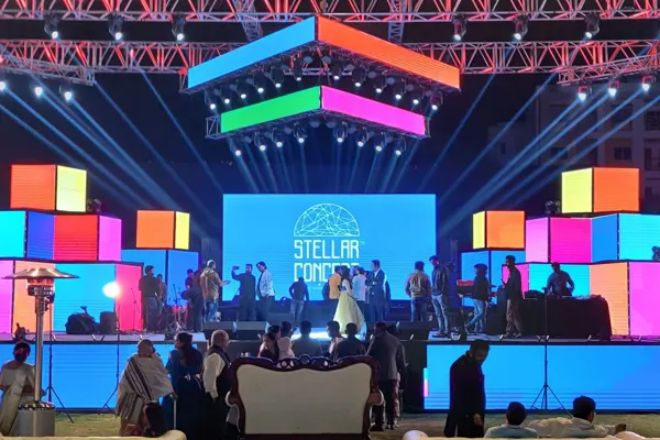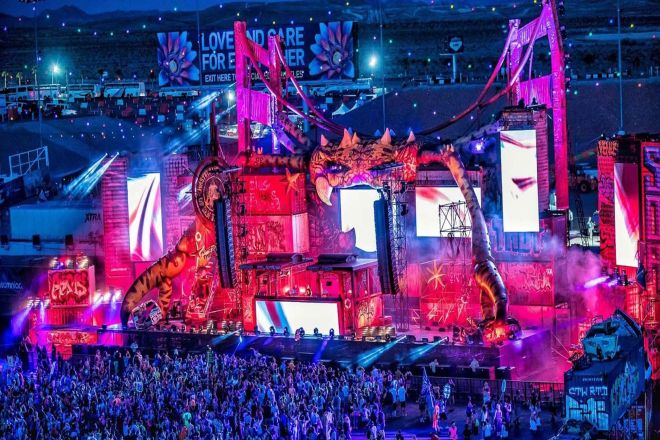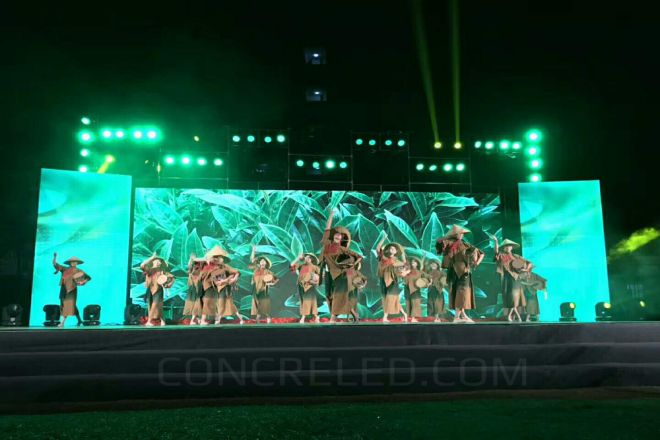소개

On the dazzling performing arts 단계, LED displays are no longer just cold display devices.
They are transformed into magicians of light and shadow, weaving creativity and dreams into stunning visual paintings. With the rapid development of science and technology, the design and application of stage LED 디스플레이 are increasingly becoming an important yardstick for measuring the success of a performance.
However, while pursuing technological innovation and visual feasts, we also have to face up to the various taboos and challenges in design. This article will explore the four major taboos in stage LED display design, analyze the root causes of the problems, and propose solutions.
1. Taboo 1: Ignore the impact of on-site environment and light
In large-scale events, performances, or exhibitions, LED displays are important tools for information display and visual focus, and their performance is directly affected by the on-site environment and light conditions.
Ignoring this factor often leads to a series of problems, affecting the audience’s viewing experience and the overall effect of the event.
1). Insufficient environmental adaptability
1.1). Problem analysis:
- Improper installation of LED display:
Failure to customize the design according to the actual size, shape, and height of the stage may cause the size of the LED display to be mismatched, the installation position to be unreasonable (such as too high or too low, angle offset), and thus cause visual blind spots or viewing discomfort.
- 제한된 시각 효과:
The complexity of the stage environment (such as background decoration, columns, auditorium layout, etc.) may block the display, or the display cannot be fully expanded due to space limitations, limiting its due visual effects and information transmission capabilities.
1.2). Improvement suggestions:
- Preliminary research and planning:
Before installing the display, conduct a detailed on-site survey and collect detailed data on the stage, including size, shape, height, obstacle location, etc., for customized design.
- Professional design team:
Hire an experienced display design team to develop a scientific and reasonable installation plan based on the on-site environment to ensure that the display can fully utilize the space and coexist harmoniously with the stage environment.
2). Light interference
2.1). Problem analysis:
- Brightness conflict:
The brightness of the stage lighting and the LED display is not reasonably matched, which may cause the screen to be too bright or too dark, affecting the clarity of the picture.
Too bright light may make the display screen difficult to recognize, while too dark light may make the display screen a “black hole” on the stage.
- Color conflict:
Improper color matching of stage lighting and display screen light may cause color distortion, color cast, or color interference, affecting the audience’s color perception and visual experience.
2.2). Solution:
- 지능형 디밍 기술:
Use the advanced intelligent dimming system to automatically adjust the brightness and color temperature of the display screen according to the real-time changes of stage lighting to ensure that the picture is always clear and the color is accurate.
- Color management:
Work closely with lighting engineers to develop a unified color management plan to ensure that the stage lighting and display screen light are coordinated and complement each other in color to create a good visual effect.
- Simulation test:
Conduct multiple simulation tests before the official event to adjust the coordination effect of the display screen and stage lighting to ensure that the best viewing effect can be achieved under different lighting conditions.
2. Taboo 2: Lack of creativity and emptiness of content on the LED display screen

In modern performances, 전시회, and various activities, LED display screens are important visual communication media, and the creativity and quality of their content directly determine the audience’s perception and experience.
However, there is a common phenomenon that too much emphasis is placed on technical performance while ignoring the creativity and depth of the content, resulting in the content of the display screen being monotonous and unattractive.
1). Lack of creativity
In the preparation stage, many projects often overemphasize the technological advancement of LED display screens, such as high 해결 그리고 높다 재생률, but ignore the creative design of the content.
This practice of simply pursuing technical stacking often makes the content on the display screen just a simple stacking of pictures and texts or special effects display, lacking novelty and storytelling and making it difficult to arouse the interest and resonance of the audience.
- 영향 분석:
The content of LED display screens lacking creativity not only fails to attract the attention of the audience but may also make the audience feel aesthetic fatigue and reduce the viewing value of the entire event.
In the highly competitive entertainment market, content lacking creativity will make it difficult to stand out and leave a deep impression.
2). Hollow content
In addition to the lack of creativity, the content of LED display screens often has the problem of being empty. This is mainly manifested in the lack of depth of the content, disconnection from the theme of the performance, or lack of emotional resonance.
For example, in concerts and other activities, the content on the LED display simply repeats the singer’s name, song title, and other basic information but fails to combine with the performance atmosphere, song emotions, etc., to form an organic whole.
- 영향 분석:
The empty LED display content not only fails to effectively convey information, but also may make the audience feel bored and confused.
In today’s world of emphasizing emotional communication and immersive experience, such content obviously cannot meet the needs of the audience, nor can it add highlights to the event.
3). Solution
- Creative planning:
Emphasis on the core position of creative planning in content production. Encourage designers to jump out of the traditional framework, innovate boldly, and combine performance themes, cultural backgrounds, audience preferences and other factors to create creative and appealing visual content.
Introduce a cross-border cooperation mechanism, invite artists and designers from different fields to participate in content creation, and inspire new creative inspiration with diversified perspectives and ideas.
- Content review and production process:
Strengthen the content review mechanism to ensure that all content meets the theme requirements and has depth and connotation. Modify or delete content that does not meet the requirements in a timely manner.
Optimize the content production process to ensure smooth and efficient connection between each link. Improve the quality and efficiency of content production through teamwork and professional division of labor.
- Combining technology and art:
While pursuing technological advancement, pay attention to the integration of technology and art. Use technical means to provide support and guarantee for creative design so that the content of the display screen is more shocking and moves in visual performance.
3. Taboo 3: LED display screen technical failures and safety hazards are not checked
In the application process of LED display screens, technical failures and safety hazards are two major issues that cannot be ignored.
They may not only directly affect the smooth progress of the performance, but also pose a threat to the life and property safety of the audience and staff. Therefore, it is necessary to attach great importance to and effectively check these potential problems.
1). Frequent technical failures
Frequent technical failures are one of the common problems in the use of LED display screens. These failures may be caused by improper equipment selection, irregular installation and debugging, and harsh use environments.
For example, the selection of display screen products with poor quality or failure to strictly follow the specifications during installation and debugging may cause the display screen to have a flower screen, black screen, flickering, and other failures during use, seriously affecting the viewing effect of the performance.
- 영향 분석:
Technical failures will not only affect the audience’s perception and experience but may also hinder the smooth progress of the performance.
Failures at critical moments may even lead to the interruption or failure of the entire performance, causing immeasurable losses to the organizer.
2). Safety hazards
The safety hazards of LED display screens are mainly reflected in two aspects: electrical safety and structural safety. Electrical safety hazards may arise from irregular line laying, overload use, equipment aging, etc., which can easily cause fires, electric shocks, and other accidents.
Structural safety hazards may be caused by factors such as unreasonable load-bearing structures and loose installation, and there are risks such as collapse and falling.
- 영향 분석:
The existence of safety hazards seriously threatens the safety of life and property of the audience and staff.
Once a safety accident occurs, it will not only cause casualties and property losses but also have a negative impact on the reputation and future development of the organizer.
3). Solution
- Select high-quality and stable LED display products:
When selecting equipment, priority should be given to LED display products with well-known brands, reliable quality, and strong stability.
By comparing the performance parameters, user reviews, and other information on different products, we ensure that high-quality products that meet the needs are purchased.
- Strengthen technical personnel training:
Strengthen the training and education of technical personnel to improve their professional quality and skills.
Ensure that technical personnel can master the installation, commissioning, maintenance, and other skills of LED display screens, strictly follow the specifications and reduce the occurrence of technical failures.
- Establish a sound safety inspection and maintenance mechanism:
Develop a sound safety inspection and maintenance system, and regularly inspect and maintain the LED display screen in terms of electrical safety and structural safety. Timely discover and eliminate safety hazards to ensure the safe and stable operation of the display screen.
Strengthen the monitoring and management of the use environment to ensure that the display screen operates under suitable environmental conditions. Avoid damage and safety hazards to the display screen caused by harsh environments.
4. Taboo 4: Ignore audience experience and interaction

In modern performing arts activities, audience experience and interaction have become one of important criteria for measuring the success of an event.
However, some event organizers have ignored this key point and only use LED display screens as a one-way information display tool, resulting in low audience participation and poor viewing experience.
This practice not only fails to arouse the interest and enthusiasm of the audience but may also make the event appear monotonous and boring.
1). One-way communication
One-way communication refers to using the LED display screen as a medium for information transmission while ignoring the subjectivity and participation of the audience as the recipient of information.
In this mode, the content on the display screen is often preset, and the audience can only passively accept it, unable to participate in it or express their opinions and feelings.
- 영향 분석:
One-way communication reduces the audience’s participation and interactivity, making the audience feel passive and alienated during the performance.
This experience not only fails to arouse the audience’s interest and enthusiasm, but also may make them bored and dissatisfied with the event.
2). Lack of interaction
Lack of interaction refers to the lack of effective interactive elements and mechanisms in the event, which makes it impossible for the audience to effectively interact and communicate with the actors, other audiences or the content on the display screen.
This lack not only weakens the audience’s sense of participation and belonging to the event, but also limits the creation of the event atmosphere and the transmission of emotions.
- 영향 분석:
The lack of interactive elements will make the audience feel monotonous and boring, and it is difficult to resonate and emotionally connect.
At the same time, it will also weaken the attractiveness and influence of the event, making it difficult for the audience to leave a deep impression on the event.
3). Solution
- Advocate the concept of interaction:
Advocate the use of LED display screens as a bridge connecting actors and audiences rather than just a tool for information display. By designing various interactive links and mechanisms, the audience can actively participate and express their opinions and feelings.
- Real-time interaction and audience participation:
Use modern scientific and technological means to achieve real-time interaction and audience participation.
For example, set up an audience voting session in the concert and display the voting results in real-time through the LED display; introduce audience interactive plots in stage performances, etc.
These methods can effectively improve the audience’s participation and viewing experience.
- Use scientific and technological means to enrich the interactive form:
Use modern scientific and technological means such as AR/VR and touch technology to enrich the interactive form and content.
For example, a touch-sensitive LED display in the exhibition can be set up so that the audience can operate and understand the exhibits by hand; AR technology can be used in theme parks to allow tourists to interact with virtual characters, etc.
These scientific and technological means can not only increase the audience’s participation and interest but also add more fun and technology to the event.
결론
In summary, the design of stage LED display screens is a complex project that integrates technology, art, safety, and audience experience. Only by deeply understanding and effectively avoiding the four taboos in design can we move forward steadily on the road of innovation and create more eye-catching visual feasts.
마지막으로 LED 디스플레이에 대해 더 알고 싶으시다면, 우리에게 연락해주세요.
